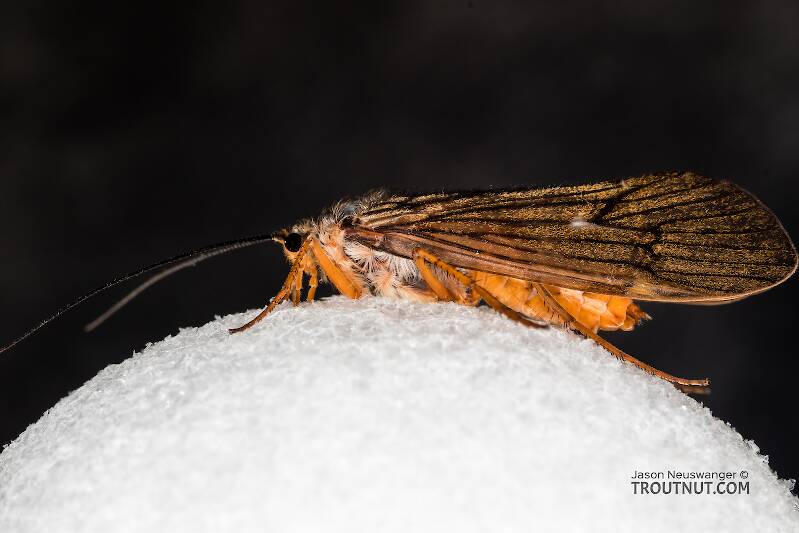
Salmonflies
Pteronarcys californica
The giant Salmonflies of the Western mountains are legendary for their proclivity to elicit consistent dry-fly action and ferocious strikes.
Featured on the forum

This dun emerged from a mature nymph on my desk. Unfortunately its wings didn't perfectly dry out.

Troutnut is a project started in 2003 by salmonid ecologist Jason "Troutnut" Neuswanger to help anglers and
fly tyers unabashedly embrace the entomological side of the sport. Learn more about Troutnut or
support the project for an enhanced experience here.
This topic is about the Insect Order Trichoptera
Some say caddisflies are even more important than mayflies, and they are probably right. The angling world has taken a while to come to terms with this blasphemy. Caddis imitations are close to receiving their fare share of time on the end of the tippet, but too many anglers still assume all caddisflies are pretty much the same.Caddis species actually provide as much incentive to learn their specifics as the mayflies do. There is just as much variety in their emergence and egg-laying behaviors, and as many patterns and techniques are needed to match them. Anglers are hampered only by the relative lack of information about caddisfly behavior and identification.
Example specimens
Troutnut on May 18, 2007May 18th, 2007, 2:48 pm EDT
I don't know why I never really realized how common this was before. I guess I wasn't paying caddisflies much detailed attention until recently, but in my last couple trips I noticed how dramatically some of them change color in between emergence and egg-laying.
The apple caddis / shadfly on the Delaware system (Brachycentrus appalachia) is the example that really caught my eye, although now that I'm looking closer I've noticed it's happening to most caddisflies I've caught lately. The apple caddis has very light tan, almost white wings when it emerges, along with a bright "apple green" body. When I got mine home to photograph, I found that they had all changed -- they now had light gray wings, and their bodies were a darker evergreen color.
This was kind of a "duh" moment for me, since it's the sort of thing I should have noticed much earlier, especially since I know it happens with some mayflies. The obvious conclusion is that the color for egg-laying adult imitations must be quite different from that of emerger imitations (and that most of the photos on this site are useless for determing the color with which to tie emergers).
So, for those who have been paying attention to this since before I started fishing: is this something that happens with all caddisflies? Have you got any related tips?
The apple caddis / shadfly on the Delaware system (Brachycentrus appalachia) is the example that really caught my eye, although now that I'm looking closer I've noticed it's happening to most caddisflies I've caught lately. The apple caddis has very light tan, almost white wings when it emerges, along with a bright "apple green" body. When I got mine home to photograph, I found that they had all changed -- they now had light gray wings, and their bodies were a darker evergreen color.
This was kind of a "duh" moment for me, since it's the sort of thing I should have noticed much earlier, especially since I know it happens with some mayflies. The obvious conclusion is that the color for egg-laying adult imitations must be quite different from that of emerger imitations (and that most of the photos on this site are useless for determing the color with which to tie emergers).
So, for those who have been paying attention to this since before I started fishing: is this something that happens with all caddisflies? Have you got any related tips?
Jason Neuswanger, Ph.D.
Troutnut and salmonid ecologist
Troutnut and salmonid ecologist
GONZO on May 19, 2007May 19th, 2007, 6:04 am EDT
Jason,
This happens not only to caddisflies, but to most emerging insects. Although the color changes are much more dramatic in some, most freshly emerged caddisflies, stoneflies, and mayflies display this to some degree. Your recent observations about the color of a freshly emerged stonefly and your photographs of appalachia (underwater shots of emergence vs. aged adult) show this clearly.
This happens not only to caddisflies, but to most emerging insects. Although the color changes are much more dramatic in some, most freshly emerged caddisflies, stoneflies, and mayflies display this to some degree. Your recent observations about the color of a freshly emerged stonefly and your photographs of appalachia (underwater shots of emergence vs. aged adult) show this clearly.
Invicta on May 30, 2007May 30th, 2007, 4:45 am EDT
Jason,
I have also noted the changing color in adult caddis flies in Brachycentrus sp., Rhaycophia sp., and Hydropsyche sp. from the Southern and Central Sierra Nevada. It seems to be more manifest in the darker colored species, and appears to occur with quicker timing in warmer weather. It is possible that our local Glossosoma sp. also show a changing color, but their appearance so late in the day has made it impossible to witness this with certainty. My observations have all been in smaller streams above 5,000’. The specimens observed have all been captured onsite, not reared artificially. Just as an idle thought I would be interested to know if night emerging species would show the same coloration change during hours of darkness, or if they wait until sunrise.
I have also noted the changing color in adult caddis flies in Brachycentrus sp., Rhaycophia sp., and Hydropsyche sp. from the Southern and Central Sierra Nevada. It seems to be more manifest in the darker colored species, and appears to occur with quicker timing in warmer weather. It is possible that our local Glossosoma sp. also show a changing color, but their appearance so late in the day has made it impossible to witness this with certainty. My observations have all been in smaller streams above 5,000’. The specimens observed have all been captured onsite, not reared artificially. Just as an idle thought I would be interested to know if night emerging species would show the same coloration change during hours of darkness, or if they wait until sunrise.
Konchu on Jun 2, 2007June 2nd, 2007, 3:46 pm EDT
Gonzo makes a very good point. Most insects experience this color change. Have you ever seen a newly emerged cicada? They are white and pale pastel colors. Then they become black and otherwise more vividly colored. Butterflies and moths don't show this as much, due to their scales, but most other insects do. When an insect is newly emerged, pale and soft, it is said to be "teneral."
DaveC
Posts: 2
Posts: 2
DaveC on Jun 18, 2007June 18th, 2007, 9:31 am EDT
There was an article by Thomas Ames, Jr. in a recent issue of Fly Fishing and Tying Journal in which his photos and narrative described the very phenomenon you describe, i.e., newly emerged aquatic invertebrates appearing pale orange, green or cream colored, but then darkening considerably within a few hours. (He also noted that many newly emerged caddis and stoneflies hold their wings upright to dry and harden, giving them an appearance that looks all the world like a newly emerged mayfly dun.)
It might be for these reasons that Ralph Cutter's E-C Caddis -- with its two-tone rust and bright green body, along with and upright wing -- is so effective.
It might be for these reasons that Ralph Cutter's E-C Caddis -- with its two-tone rust and bright green body, along with and upright wing -- is so effective.
GONZO on Jun 18, 2007June 18th, 2007, 9:41 am EDT
Good point, Dave. Many caddisflies do hold their wings vertically when they emerge. Stoneflies often do this too, but since most emerge out of the stream, the resemblance to upright-winged mayflies is probably less significant from an imitation standpoint. The darkening often occurs much faster than a few hours. It can happen within a few minutes in many cases, though darkening may continue for some time.
Quick Reply
Related Discussions
Topic
Replies
Last Reply
14
Jan 29, 2015
by Lastchance
by Lastchance
1
Oct 28, 2008
by GONZO
by GONZO
3
Jul 5, 2017
by Crepuscular
by Crepuscular






